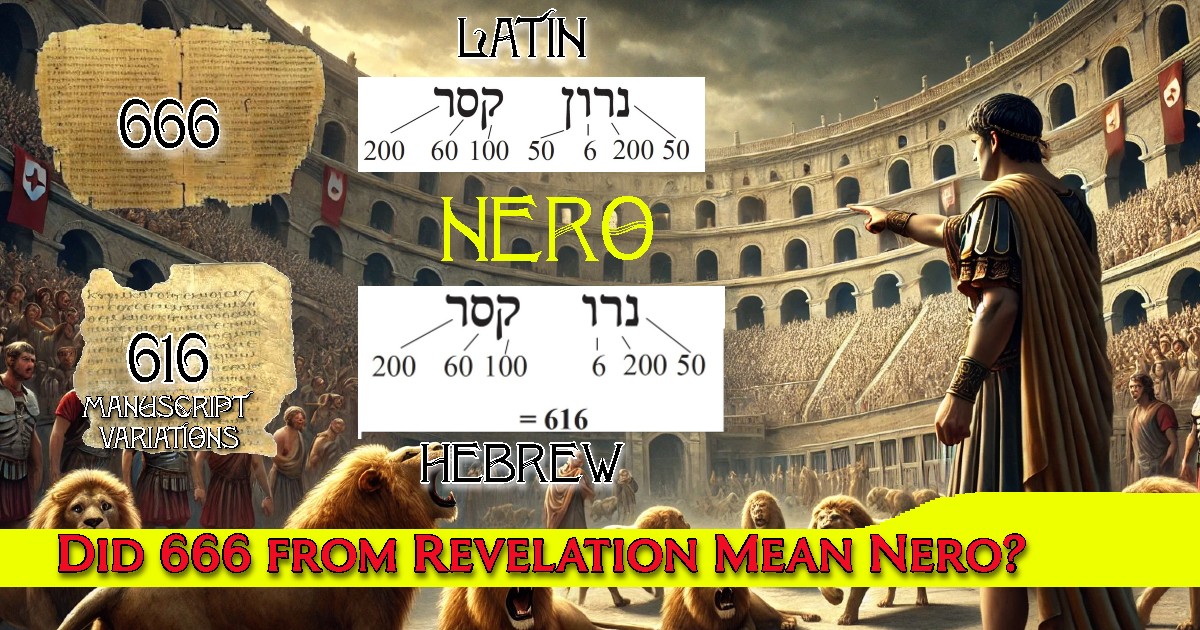The Book of Revelation has long fascinated scholars, theologians, and historians, particularly the enigmatic number 666 found in Revelation 13:18:
“This calls for wisdom: let the one who has understanding calculate the number of the beast, for it is the number of a man, and his number is 666.”
Who is this “beast,” and what does this number signify? Some early manuscripts of Revelation list 616 instead of 666, adding another layer of mystery to the interpretation. One of the most compelling theories is that 666 refers to Emperor Nero, the infamous Roman ruler who persecuted early Christians. The evidence for this interpretation is extensive, spanning linguistic, historical, and theological grounds. Below, we delve into the key aspects that support this theory.
Gematria and the Numerical Value of Nero’s Name
The strongest argument linking 666 to Nero comes from gematria, a system in which letters correspond to numerical values. The Book of Revelation, written in Greek but deeply influenced by Hebrew thought, likely used this method.
In Hebrew, Nero’s name can be transliterated as “Neron Kaisar” (נרון קסר). When we calculate its numerical value:
- נ (Nun) = 50
- ר (Resh) = 200
- ו (Vav) = 6
- ן (Final Nun) = 50
- ק (Qoph) = 100
- ס (Samekh) = 60
- ר (Resh) = 200
The total is 666, directly matching the number of the Beast.
Additionally, some early manuscripts of Revelation list 616 instead of 666. This makes sense because if Nero’s name is spelled in Latin rather than Hebrew, the value drops to 616. This variation suggests that early Christians were aware of the numerical link to Nero and adjusted the calculation accordingly.
Nero’s Persecution of Christians
A key reason early Christians viewed Nero as the “Beast” was his ruthless persecution of their faith. In 64 CE, Rome suffered a great fire, and Nero was widely suspected of orchestrating it to clear land for his grand architectural projects. To deflect blame, he accused Christians, leading to the first major imperial persecution.
Early sources, including the Roman historian Tacitus (Annals 15.44), describe the horrific methods Nero used:
- Christians were torn apart by dogs in public spectacles.
- Others were crucified and left to die.
- Some were burned alive as human torches to light Nero’s gardens at night.
Given this brutal treatment, it is no surprise that Christians saw Nero as a monstrous figure—the very embodiment of the Beast described in Revelation.
The Nero Redivivus Legend and the Wounded Beast
Revelation 13:3 describes the Beast as having a mortal wound that healed, causing people to marvel at it:
“One of the heads of the beast seemed to have had a fatal wound, but the fatal wound had been healed. The whole world was filled with wonder and followed the beast.”
This passage aligns with the Nero Redivivus legend, a belief that emerged after Nero’s death in 68 CE. Many people refused to believe he was truly dead and thought he would return to reclaim power. Multiple impostors even appeared, claiming to be Nero reborn.
If John, the author of Revelation, was writing after Nero’s death but during the time of this legend, he could have been referencing this widespread belief, further solidifying the connection between Nero and the Beast.
The Roman Imperial Cult and Christian Resistance
Another reason why early Christians associated Nero with the Beast was the growing imperial cult, where Roman emperors were worshiped as divine beings. Nero aggressively promoted his own divinity:
- He built the Colossus of Nero, a massive statue depicting himself as a god.
- He demanded emperor worship, which directly conflicted with Christian monotheism.
- He persecuted those who refused to offer sacrifices in his name.
Revelation describes the Beast as demanding worship and punishing those who refuse (Revelation 13:15), a situation that matches Nero’s religious policies.
The Context of Revelation: Roman Oppression
Revelation was written during a time of intense Roman oppression against Jews and Christians. If it was penned during or after Nero’s reign, it would make sense for the writer to encode a hidden message about Nero as the Beast.
Why hide the name in gematria? Directly criticizing the Roman Emperor was dangerous. By using numerical symbolism, the message could be understood by those “with wisdom” (Revelation 13:18) while being obscure to outsiders.
Additionally, Revelation frequently refers to “Babylon” as a coded term for Rome (Revelation 17:9 identifies it as the city on seven hills—Rome’s well-known geography). This confirms that the book’s warnings are about Roman persecution, reinforcing the Nero connection.
The evidence that 666 refers to Nero is overwhelming and is the consensus opinion of modern scholarship familiar with the time period. From gematria calculations and manuscript variations to historical persecution, the Book of Revelation appears to be directly addressing Nero as the Beast. His cruelty towards Christians, his self-deification, and the belief that he would return all align with the apocalyptic imagery used in Revelation.
Sources:
- Tacitus, Annals 15.44 (describing Nero’s persecution of Christians)
- Suetonius, The Lives of the Caesars: Nero (on Nero’s self-deification)
- Cassius Dio, Roman History 62.16-18 (on Nero’s tyranny)
- Irenaeus, Against Heresies 5.30.1 (discussing the meaning of 666)
- The Dead Sea Scrolls (showing early Jewish use of gematria)
- The Book of Revelation (biblical text referencing 666 and the Beast)
While some alternative theories exist, the historical and textual evidence overwhelmingly supports Nero as the intended reference. Revelation, written in a time of great persecution, likely sought to encourage early Christians by affirming that Rome’s tyranny would not last forever.

